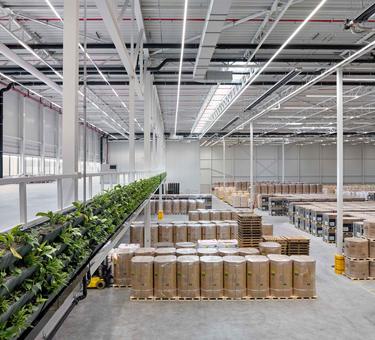
Four tactics how logistics real estate gets the job done
The importance of labour in warehouses has only risen in the past decade. Access to qualified labour in the 12 European countries where Prologis operates is a key requirement for real estate selection. Based on our platform of more than 16 million square metres, numerous conversations with many of our roughly 700 unique customers and our proprietary data, we have begun to develop a clear picture of the interaction between labour retention and logistics real estate. Given this understanding, we have the opportunity to share insights and offer solutions to source, train and retain warehouse labour.
More than 150,000 people work under Prologis roofs in Europe, and their environment has never been more important. A warehouse is no longer just a place for only storing goods. Higher value-added and complex activities now take place in logistics facilities, which require a much more diverse workforce than historical norms.
Labour presents challenges from many angles, and there are a wide range of potential solutions—some proven, some speculative, some counterproductive. At their core, labour challenges are encompassed by a need to attract, train and retain employees. Simplistically, real estate companies have tried to focus on the basics, but forward-thinking operations divide the approach into a wider range of solutions, including:
- Better transport connections: Commuting needs to be as efficient as possible.
- More and higher-quality amenities: As labour qualifications increase, amenities become more important.
- Logistics career and community commitment: A long-term initiative improves the overall image of the logistics sector and creates lasting solutions.
- Improvement of building characteristics: A basic component of a pleasant and healthy workplace hinges on the facility’s environment.
Our Approach
Warehouse labour insights in this paper are based on our more than 16 million square metres of portfolio, conversations with many of our approximately 700 unique customers in Europe and two proprietary surveys.
One survey, a collaboration with Eyefortransport, explored industry perceptions about labour trends today and in the future. In this market survey, we polled warehouse users (206 respondents) from a range of sectors and markets. The second survey, conducted exclusively by Prologis, asked a selection of our customers (150 warehouse logistics real estate managers across Europe) about the shape of their labour pool. Both surveys were carried out between December 2018 and January 2019.
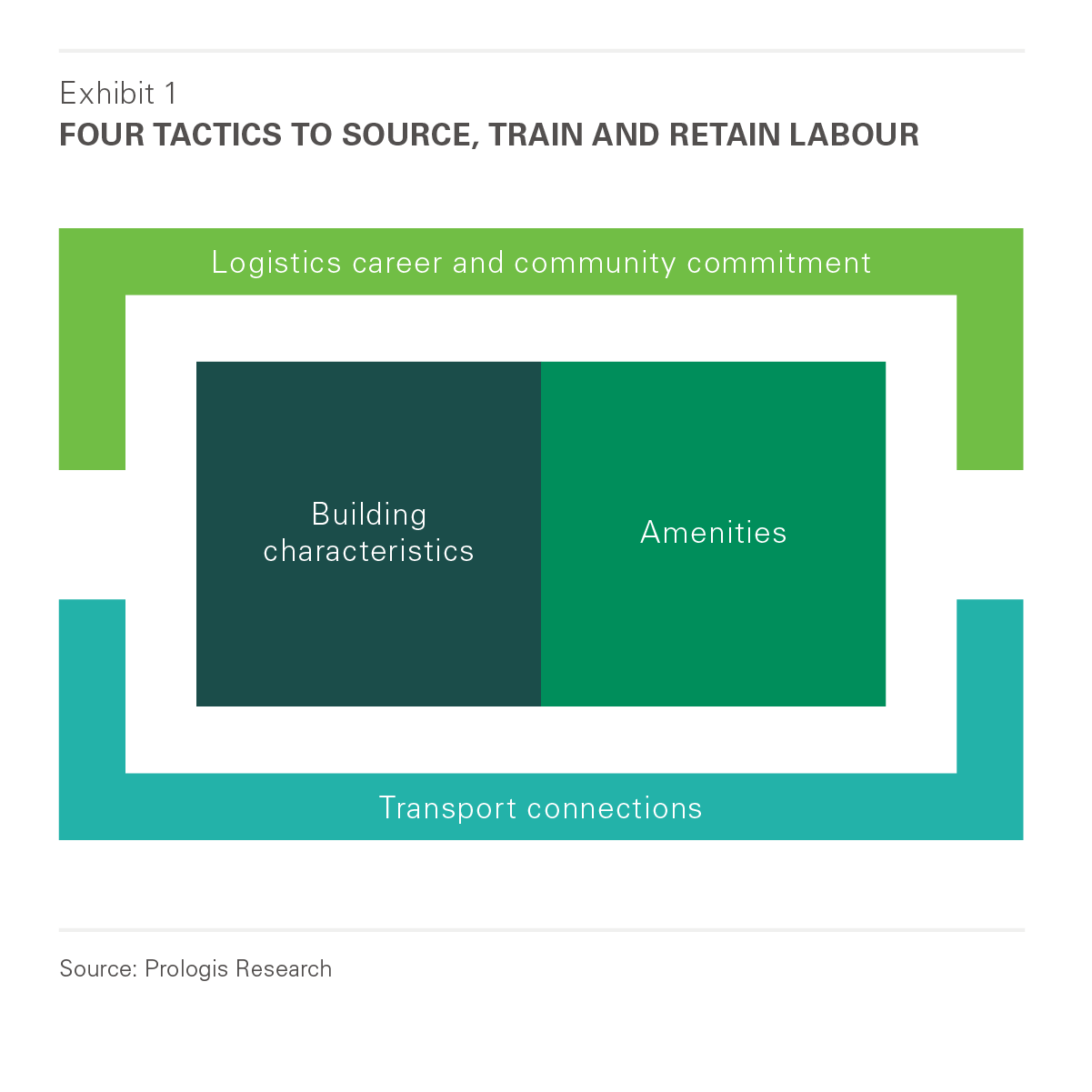
Understanding the Challenge
Labour in logistics facilities is more pronounced than many perceive. The total warehouse workforce in the European Union is 3.3 million1. Based on our customer insights, an average European facility employs over 100 people per 10,000 square metres of floor space, but the numbers vary widely depending on the market and type of operation. For instance, e-fulfilment centres employ upward of 10x more employees compared to offline retailers like traditional brick-and-mortar retailers.
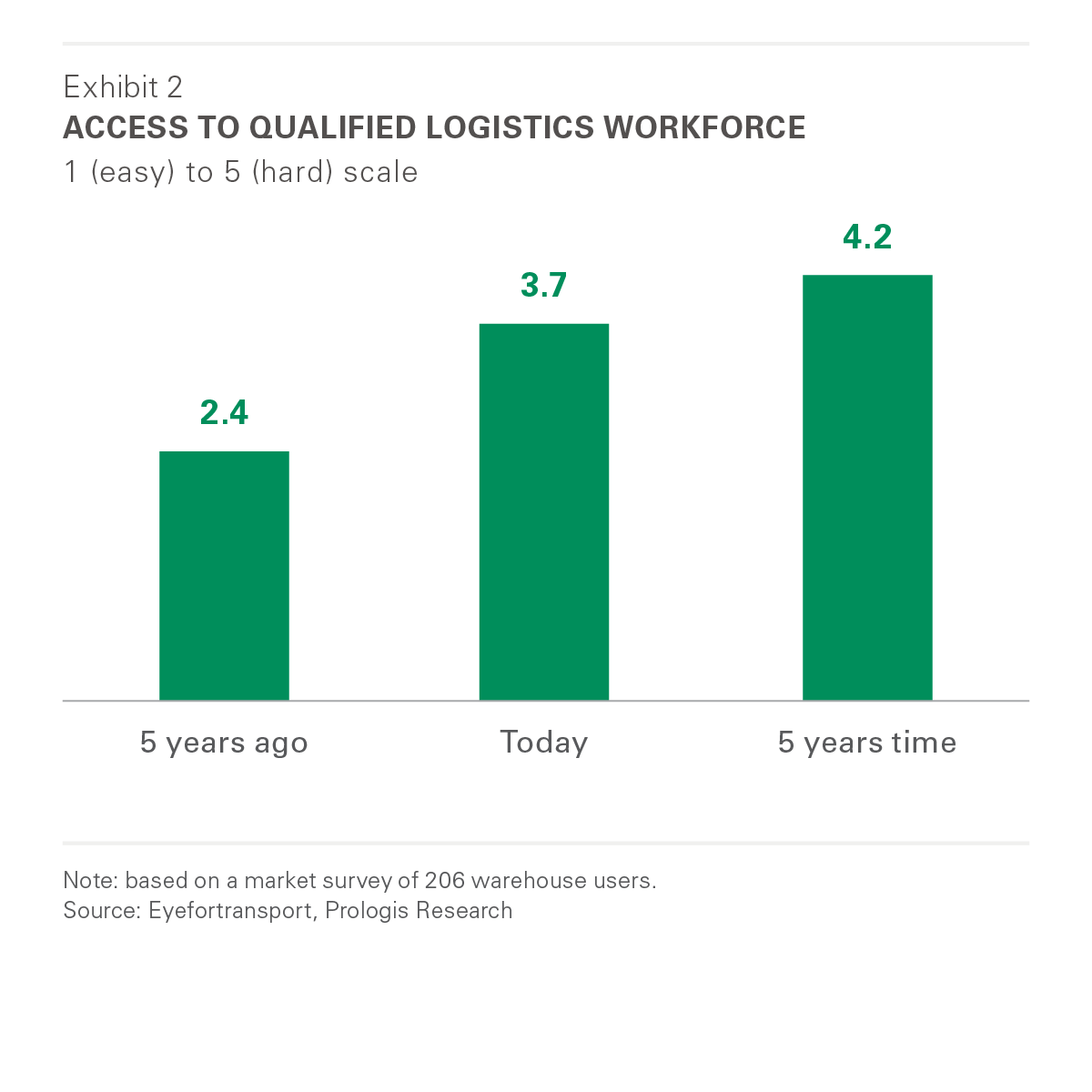
Labour has risen to a top priority among customers. Job vacancies in the logistics sector are increasing. In only five years, the European job vacancy rate has doubled to almost 3 percent2. Markets facing the highest job vacancy are the Czech Republic (5.6 percent), Germany (4 percent) and Benelux (3.5 percent). Employee scarcity is viewed both cyclically and structurally. The nature of work in logistics facilities is changing: Structural scarcity is driven by increasing levels of value-added services, and an aging workforce creates demographic challenges.
Community Workforce Initiative
Identifying Best Practice Solutions
We have identified four different tactics for how logistics real estate owners can help attract, train and retain labour forces3:
1. Better transport connections: Time spent commuting needs to be as efficient as possible to attract and retain a workforce. In addition to accessibility by car, public transport has become more important. Tools include:
- The traditional approach has included developing and expanding bike paths and bus shuttles in many European markets.
- Modern approaches include mobile apps to encourage employee car sharing. Successful pilots have been introduced in the United Kingdom, for example.
2. More and higher-quality amenities: Another tactic to attract and retain labour, particularly as labour qualifications increase include addressing the amenities set. Innovation goes beyond market norms of the past:
- Higher access to better and a wider variety of quality food offered by in-house restaurants and food trucks during lunch breaks, now a common occurrence across many countries with top examples in Germany, Poland and the Netherlands.
- Indoor and outdoor social and recreational areas appeal to employees. There are a wide range of examples across Europe, different parks have different initiatives. Some parks offer BBQ areas (Hungary), a sauna and bowling lanes (Sweden) or coffee bars (Italy). Opportunities to play sports are also well represented, such as football (the Netherlands and Hungary), outdoor gym and padel courts (Spain), and basketball (Italy).
- Additional innovations being tested include child care in France and supplemental facilities for truck drivers (such as hotel, restaurant and shower facilities) in Slovakia.
3. Logistics career and community commitment: A third tool to attract, retain and train employees includes long-term initiatives to improve the overall image of the logistics sector. This is a new development in the market, and most programs are just taking shape. A few references include:
- Park newsletters in the United Kingdom and narrow casting screens in the Netherlands aim to share the latest news about the logistics park with employees and bolster a sense of community and loyalty.
- A logistics park in Hungary organized a football tournament for all of its customers’ employees.
- A program for internships at logistics parks in Poland involves students who are studying logistics at bachelor and master levels.
4. Improvement of building characteristics: A growing category to retain employees includes improving the work environment, much like office environments have seen in the past decade. The basic component for a pleasant and healthy workplace is comfort. Most investments are focused on the asset itself, including upgrades to lighting (specifically LED), improved ventilation and an increased focus on safety. The best developments are designed with these specifications in mind at the outset, but existing stock is also seeing these improvements.
WELL Building Standard
A new initiative encompassing all four tactics is the WELL Building Standard. This concept is known within the residential and office sectors. Prologis worked closely with the International WELL Building Institute™ to come up with a WELL standard for logistics buildings. The first European facility to comply with the WELL Building Standard was completed by Prologis in 2018 in Tilburg, the Netherlands.
The WELL Building Standard is a performance-based system to measure, certify and monitor features of the built environment that impact human health and well-being, including air, water, nourishment, light, fitness, comfort and mind.
Investing in WELL buildings has beneficial returns. A better indoor climate and abundant natural daylight are linked to lower absenteeism, higher productivity and positive health outcomes. Specific design features in the new building in Tilburg include a green balustrade and plant wall, biodynamic lighting, a bike share plan, air quality monitoring sensors, ecological landscaping, low-emitting building finishes and drinking water faucets throughout the facility. WELL-standard is the new direction building design is headed.
PROLOGIS DC5 IN TILBURG, THE NETHERLANDS
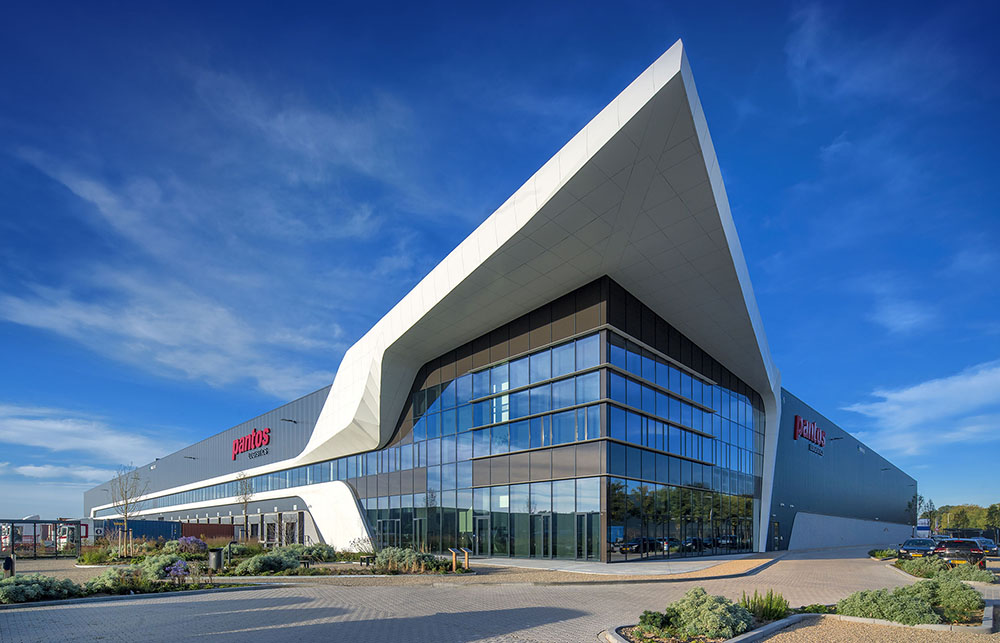
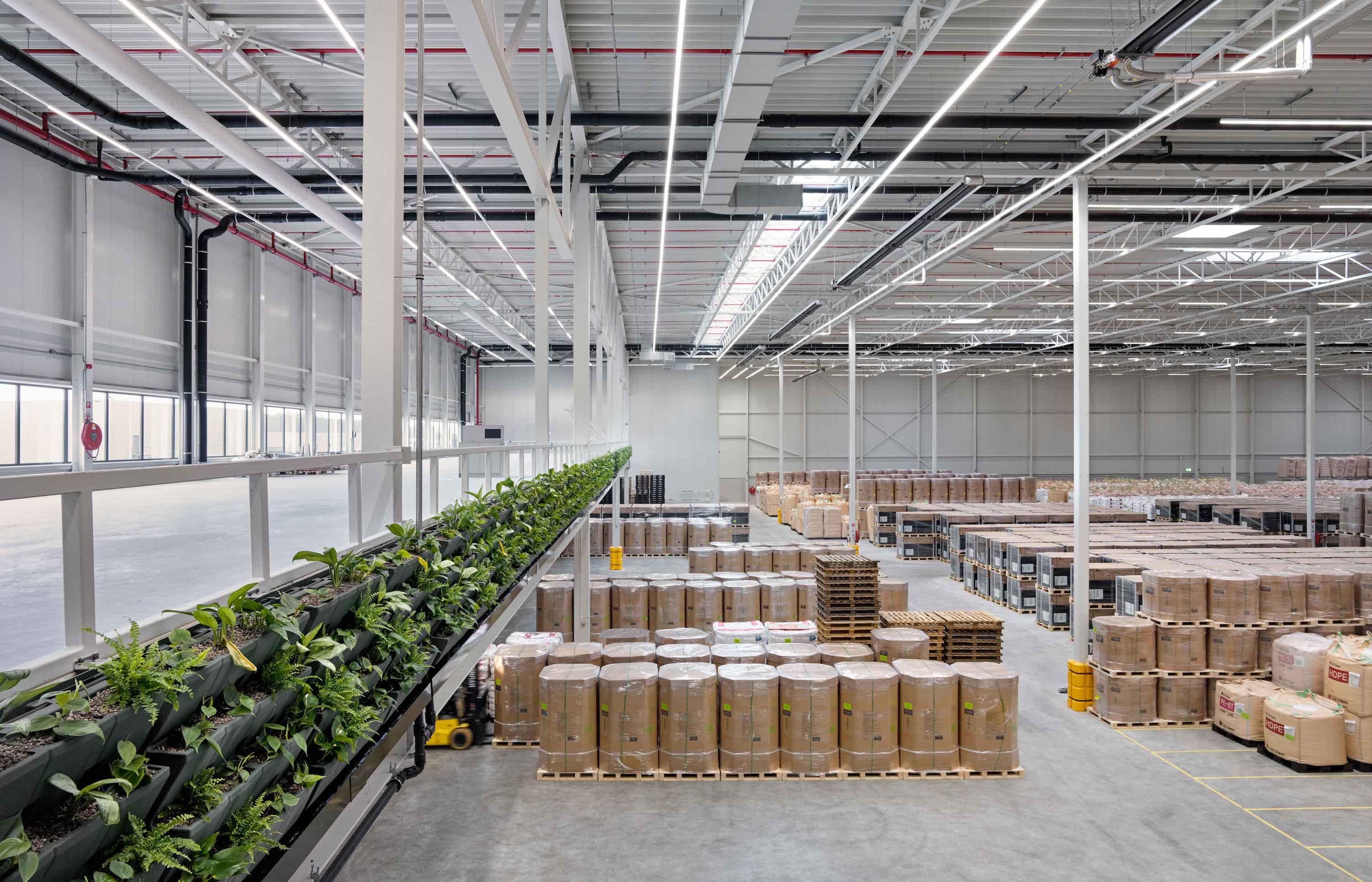
Developing New Capabilities and Insights
Prologis has begun to develop and investigate proprietary data as it relates to measuring and benchmarking labour challenges and corresponding solutions.
Workforce availability has become a key location requirement. Labour availability, quality and flexibility are one of the top drivers of location decisions. The dual challenges of cyclical and structural trends mean labour should only rise in importance in the coming years. Based on results from our market survey, access to qualified employees is already challenging (score 3.74) and expected to become even more difficult in five years (score 4.24).
Labour scarcity leads customers to adapt by consolidating operations in and near major population centres. Consolidation within a certain (sub)market, or even park, is the preferred location strategy. Over half of all respondents to our market survey would implement this strategy if they needed to expand. The main driver for this approach is the nearby labour pool. The market survey results also show that over 85 percent of employees are based inside a 30- kilometre radius. Because labour is scarce, retaining the existing labour force is the first priority among many logistics facility operators. Relocating outside a (sub)market would lead to a significant loss of this current workforce. This consolidation trend, together with favouring nearby labour pools, is expected to lead (and has led) to an increased focus on populated areas. Remote locations—while perhaps offering lower real estate costs, reduced tax and other incentives—are falling out of favour because they offer neither the quantity nor quality of labour. This trend might help explain the recent high retention rates at renewal that have prevailed as the market cycle has accelerated.
Automation relieves labour scarcity, but not for all qualifications. Automation is not new. Supply chains have a long history of deploying equipment to enhance productivity since labour represents a large portion of the total supply chain cost. We’ve seen this trend for a number of decades, starting with the introduction of conveyer belts. A recent Prologis Research study (Innovation, Disruption and the Value of Time: The Next 10 Years in Logistics Real Estate) unveils that labour is one of the biggest cost components in a supply chain, accounting for roughly 25 to 30 percent. Escalating labour costs and scarcity are main drivers for rising automation rates. Adoption levels today, however, are still moderate, rising only gradually because supply chain complexity hampers ROIs for higher levels of investment. Although not broadly financially viable yet, innovations will doubtlessly expand capabilities and reduce costs.
We believe the logistics market is on the verge of transforming its labour market. Our market survey shows that automation/robotics impacts labour demand. Respondents expect this to reduce some pressure for lower-qualified employees, but the need for higher-qualified employees will only rise. As seen in other sectors, automation/robotics doesn’t necessarily lead to a reduced need for staff—it leads to a changing composition of the employee skillset.
Proprietary survey data from Prologis customers already shows a broad mix of different functions in logistics facilities. Approximately half are categorized as warehouse staff. The other half consists of office staff (20 percent), drivers (7 percent), managerial staff (6 percent) and other functions (15 percent). As value-adding activities in facilities increase, we expect a further mix of functions.
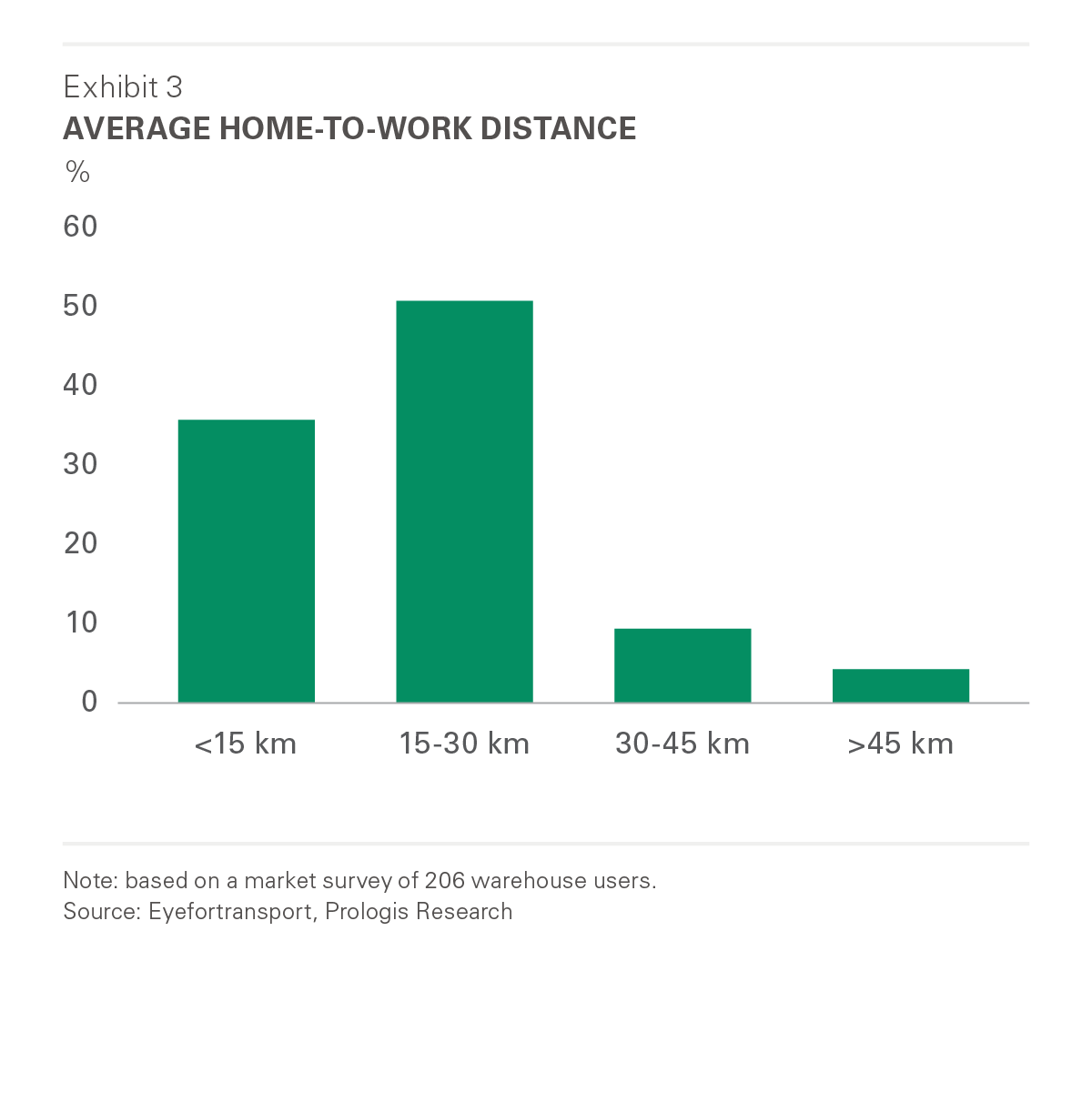
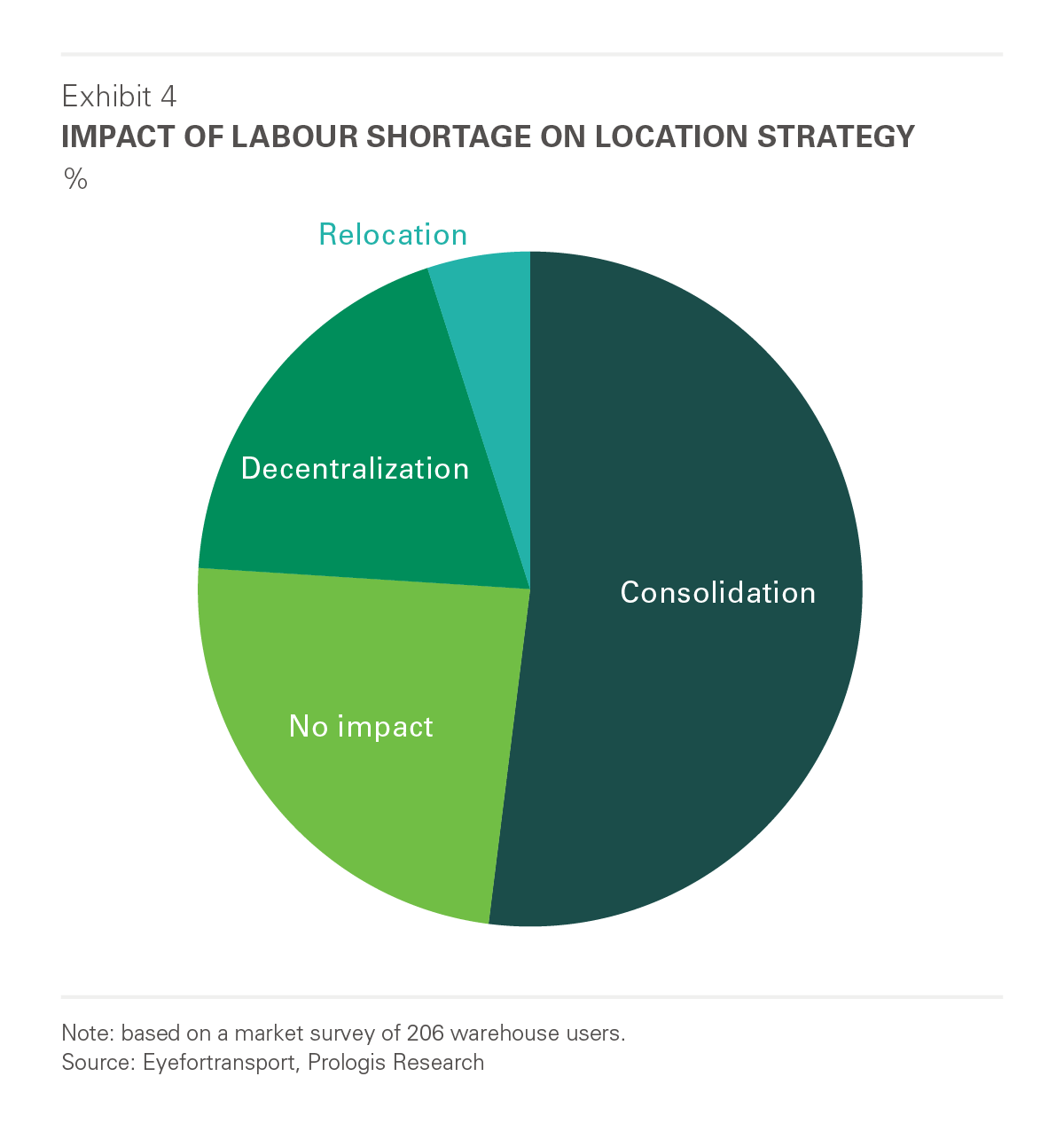
Logistics real estate has the opportunity to alleviate today’s challenges and provide solutions for the future. Operators of logistics facilities continue to introduce initiatives to help overcome today’s labour challenges. Focus areas include career development programs to attract and retain labour. Specific programs are based around preboarding new employees, reorientation programs for aging employees and a shift toward a gig economy that requires offering employees the flexibility to work when it suits them best.
A warehouse is not a place for only storing goods, and long-term owners have the opportunity to create a better work environment for their customers’ employees. Creating a better place to work can alleviate a wide palette of today’s challenges and provide solutions for the future, starting with sourcing a new workforce: customers offering a state-of-the art work environment distinguish themselves from other logistics operators. Once new employees are on board, the next challenge is retention. Market anecdotes reveal that employee retention rates are low. In some cases, only 50 percent stay with an employer for three months or more. Constant workforce hiring and education eventually drags down operational productivity. Employment in a warehouse with good accessibility, the latest building amenities and community loyalty supports higher retention rates. Ultimately, higher retention rates and enjoyable work environments go hand in hand and lead to higher operational productivity.
Conclusion
Access to labour is essential and the availability is shaping location strategies. It has become one of the most important themes in today’s logistics market. Logistics real estate has an opportunity to address these needs by offering well-equipped warehouses in accessible locations. In the long term, real estate providers can offer support with continued investment in education and community commitment. Facilitating labour solutions improves long-term relationships with customers and drives a positive investment thesis—and above all, it is a responsibility that all parties in the sector should embrace.
Endnotes
Forward-Looking Statements
This material should not be construed as an offer to sell or the solicitation of an offer to buy any security. We are not soliciting any action based on this material. It is for the general information of customers of Prologis.
This report is based, in part, on public information that we consider reliable, but we do not represent that it is accurate or complete, and it should not be relied on as such. No representation is given with respect to the accuracy or completeness of the information herein. Opinions expressed are our current opinions as of the date appearing on this report only. Prologis disclaims any and all liability relating to this report, including, without limitation, any express or implied representations or warranties for statements or errors contained in, or omissions from, this report.
Any estimates, projections or predictions given in this report are intended to be forward looking statements. Although we believe that the expectations in such forward-looking statements are reasonable, we can give no assurance that any forward-looking statements will prove to be correct. Such estimates are subject to actual known and unknown risks, uncertainties and other factors that could cause actual results to differ materially from those projected. These forward-looking statements speak only as of the date of this report. We expressly disclaim any obligation or undertaking to update or revise any forward-looking statement contained herein to reflect any change in our expectations or any change in circumstances upon which such statement is based.
No part of this material may be (i) copied, photocopied, or duplicated in any form by any means or (ii) redistributed without the prior written consent of Prologis.
About Prologis Research
Prologis’ Research department studies fundamental and investment trends and Prologis’ customers’ needs to assist in identifying opportunities and avoiding risk across four continents. The team contributes to investment decisions and long-term strategic initiatives, in addition to publishing white papers and other research reports. Prologis publishes research on the market dynamics impacting Prologis’ customers’ businesses, including global supply chain issues and developments in the logistics and real estate industries. Prologis’ dedicated research team works collaboratively with all company departments to help guide Prologis’ market entry, expansion, acquisition and development strategies.
About Prologis
Prologis, Inc., is the global leader in logistics real estate with a focus on high-barrier, high-growth markets. As of December 31, 2018, the company owned or had investments in, on a wholly owned basis or through co-investment ventures, properties and development projects expected to total approximately 768 million square feet (71 million square meters) in 19 countries. Prologis leases modern logistics facilities to a diverse base of approximately 5,100 customers across two major categories: business-to-business and retail/online fulfillment.

